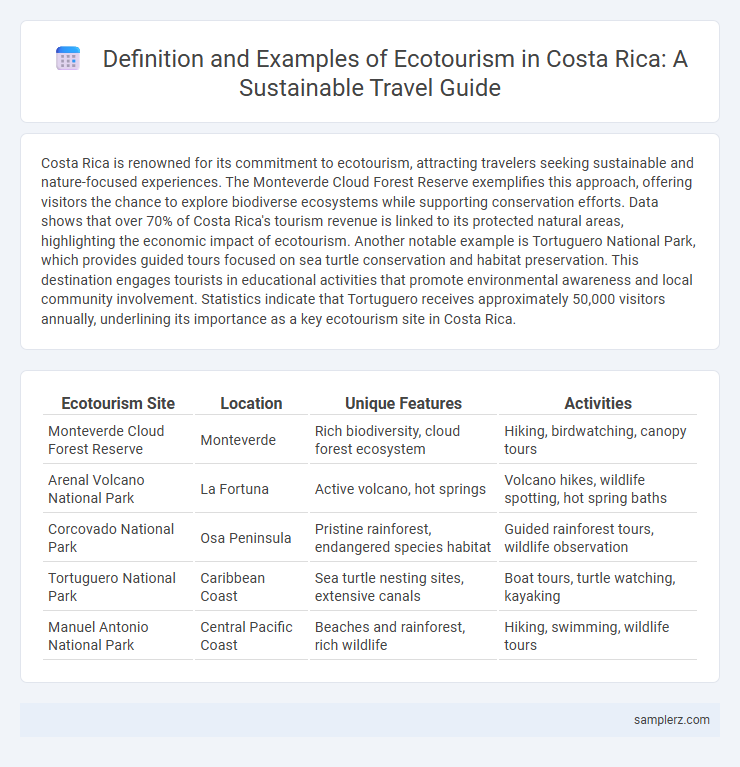Costa Rica is renowned for its commitment to ecotourism, attracting travelers seeking sustainable and nature-focused experiences. The Monteverde Cloud Forest Reserve exemplifies this approach, offering visitors the chance to explore biodiverse ecosystems while supporting conservation efforts. Data shows that over 70% of Costa Rica's tourism revenue is linked to its protected natural areas, highlighting the economic impact of ecotourism. Another notable example is Tortuguero National Park, which provides guided tours focused on sea turtle conservation and habitat preservation. This destination engages tourists in educational activities that promote environmental awareness and local community involvement. Statistics indicate that Tortuguero receives approximately 50,000 visitors annually, underlining its importance as a key ecotourism site in Costa Rica.
Table of Comparison
| Ecotourism Site | Location | Unique Features | Activities |
|---|---|---|---|
| Monteverde Cloud Forest Reserve | Monteverde | Rich biodiversity, cloud forest ecosystem | Hiking, birdwatching, canopy tours |
| Arenal Volcano National Park | La Fortuna | Active volcano, hot springs | Volcano hikes, wildlife spotting, hot spring baths |
| Corcovado National Park | Osa Peninsula | Pristine rainforest, endangered species habitat | Guided rainforest tours, wildlife observation |
| Tortuguero National Park | Caribbean Coast | Sea turtle nesting sites, extensive canals | Boat tours, turtle watching, kayaking |
| Manuel Antonio National Park | Central Pacific Coast | Beaches and rainforest, rich wildlife | Hiking, swimming, wildlife tours |
Overview of Ecotourism in Costa Rica
Costa Rica stands as a global leader in ecotourism, boasting over 25% of its land protected as national parks and reserves, including renowned sites like Corcovado National Park and Monteverde Cloud Forest Reserve. Ecotourism initiatives emphasize sustainable travel practices that conserve biodiversity and support local communities, attracting millions of eco-conscious travelers annually. The country's commitment to renewable energy and wildlife conservation creates immersive experiences such as guided nature hikes, birdwatching tours, and volunteer programs in conservation projects.
Exploring Monteverde Cloud Forest Reserve
Exploring Monteverde Cloud Forest Reserve offers travelers an unparalleled ecotourism experience with its rich biodiversity and conservation efforts. Visitors can hike through misty trails, spotting rare wildlife like the resplendent quetzal and various orchid species. The reserve's sustainable tourism practices support local communities while preserving the delicate cloud forest ecosystem.
Sustainable Adventures in Tortuguero National Park
Tortuguero National Park in Costa Rica offers sustainable adventures centered around ecotourism, featuring guided boat tours through its extensive mangrove canals that protect endangered sea turtles. Visitors engage in wildlife observation, including rare species such as jaguars and toucans, while supporting conservation efforts and local communities. The park's eco-friendly lodges and strict environmental regulations ensure minimal impact on its pristine rainforests and marine ecosystems.
Wildlife Conservation at Corcovado National Park
Corcovado National Park in Costa Rica is a prime example of ecotourism dedicated to wildlife conservation, protecting diverse species such as jaguars, scarlet macaws, and tapirs. The park's preservation efforts maintain one of the most biologically intense places on Earth, promoting sustainable tourism that supports local ecosystems. Visitors engage in guided tours that emphasize minimal environmental impact while contributing to conservation funding and community education.
Arenal Volcano: Eco-Friendly Activities
Arenal Volcano in Costa Rica offers eco-friendly activities such as guided nature hikes through the rainforest, bird watching tours featuring native species, and visits to sustainable hot springs powered by geothermal energy. These experiences emphasize environmental conservation and promote local community involvement. Eco-lodges around Arenal prioritize renewable energy use and waste reduction to minimize tourism's ecological footprint.
Community-Based Tourism in Sarapiquí
Sarapiqui in Costa Rica is a prime example of community-based ecotourism, where local residents actively manage sustainable tourism initiatives. Visitors engage in guided tours of biodiverse rainforests, participate in organic farming experiences, and support conservation efforts that protect endangered wildlife. This model promotes economic growth while preserving ecological integrity and cultural heritage.
Marine Conservation in Cahuita National Park
Cahuita National Park in Costa Rica is a prime example of ecotourism dedicated to marine conservation, featuring extensive coral reefs and diverse marine species such as sea turtles and manatees. The park implements sustainable snorkeling and guided tours that minimize ecological impact while educating visitors on the importance of protecting marine biodiversity. Conservation initiatives within Cahuita actively monitor coral health and promote the community's involvement in preserving this critical coastal ecosystem.
Eco-Lodges and Green Accommodations
Costa Rica is renowned for its eco-lodges that blend sustainability with comfort, such as the Lapa Rios Lodge, which operates on renewable energy and supports rainforest conservation. Many green accommodations in Costa Rica use locally sourced materials and implement water-saving systems to minimize environmental impact. These eco-friendly stays offer travelers immersive experiences in biodiversity hotspots while promoting responsible tourism practices.
Birdwatching Paradises: Key Spots
Costa Rica's Monteverde Cloud Forest Reserve offers unparalleled birdwatching opportunities with species like the resplendent quetzal and three-wattled bellbird thriving in its lush canopy. The Osa Peninsula, home to Corcovado National Park, is another key birdwatching hotspot, where rare birds such as the scarlet macaw and harpy eagle can be observed in pristine habitats. These protected areas contribute significantly to eco-tourism by promoting wildlife conservation and supporting local communities.
Supporting Local Culture Through Ecotourism
Costa Rica's ecotourism initiatives, such as visits to indigenous reserves and community-run lodges, prioritize supporting local culture by showcasing traditional crafts, rituals, and sustainable agriculture. These experiences provide financial benefits directly to local communities, promoting cultural preservation and environmental stewardship. Tourists engage in authentic cultural exchanges while minimizing their ecological footprint, reinforcing Costa Rica's commitment to responsible travel.

example of ecotourism in Costa Rica Infographic
 samplerz.com
samplerz.com